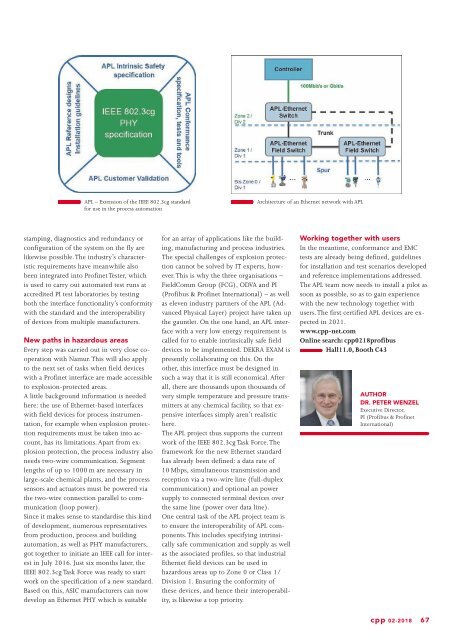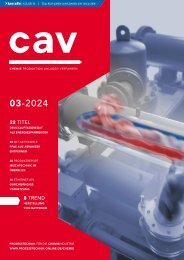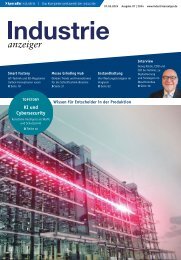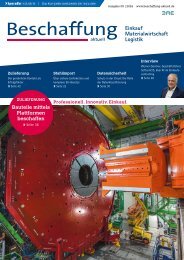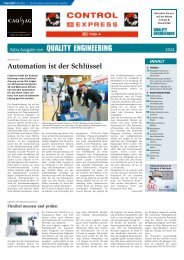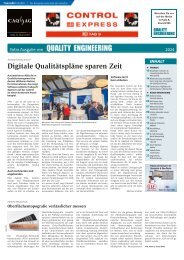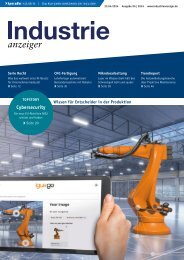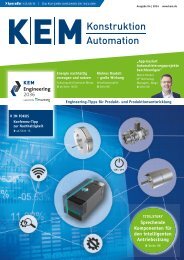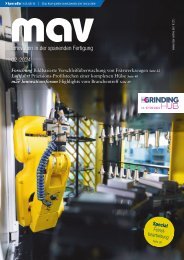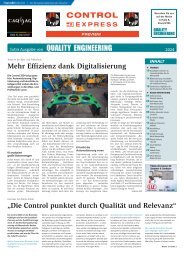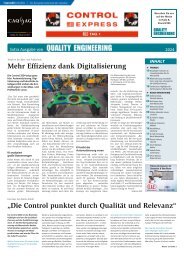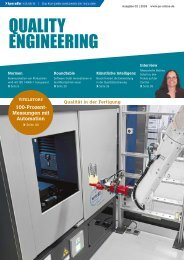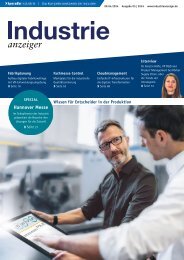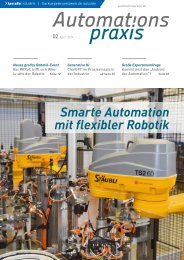cpp - Process technology for the chemical industry 02.2018
Create successful ePaper yourself
Turn your PDF publications into a flip-book with our unique Google optimized e-Paper software.
APL – Extension of <strong>the</strong> IEEE 802.3cg standard<br />
<strong>for</strong> use in <strong>the</strong> process automation<br />
Architecture of an E<strong>the</strong>rnet network with APL<br />
stamping, diagnostics and redundancy or<br />
configuration of <strong>the</strong> system on <strong>the</strong> fly are<br />
likewise possible. The <strong>industry</strong>’s characteristic<br />
requirements have meanwhile also<br />
been integrated into Profinet Tester, which<br />
is used to carry out automated test runs at<br />
accredited PI test laboratories by testing<br />
both <strong>the</strong> interface functionality’s con<strong>for</strong>mity<br />
with <strong>the</strong> standard and <strong>the</strong> interoperability<br />
of devices from multiple manufacturers.<br />
New paths in hazardous areas<br />
Every step was carried out in very close cooperation<br />
with Namur. This will also apply<br />
to <strong>the</strong> next set of tasks when field devices<br />
with a Profinet interface are made accessible<br />
to explosion-protected areas.<br />
A little background in<strong>for</strong>mation is needed<br />
here: <strong>the</strong> use of E<strong>the</strong>rnet-based interfaces<br />
with field devices <strong>for</strong> process instrumentation,<br />
<strong>for</strong> example when explosion protection<br />
requirements must be taken into account,<br />
has its limitations. Apart from explosion<br />
protection, <strong>the</strong> process <strong>industry</strong> also<br />
needs two-wire communication. Segment<br />
lengths of up to 1000 m are necessary in<br />
large-scale <strong>chemical</strong> plants, and <strong>the</strong> process<br />
sensors and actuators must be powered via<br />
<strong>the</strong> two-wire connection parallel to communication<br />
(loop power).<br />
Since it makes sense to standardise this kind<br />
of development, numerous representatives<br />
from production, process and building<br />
automation, as well as PHY manufacturers,<br />
got toge<strong>the</strong>r to initiate an IEEE call <strong>for</strong> interest<br />
in July 2016. Just six months later, <strong>the</strong><br />
IEEE 802.3cg Task Force was ready to start<br />
work on <strong>the</strong> specification of a new standard.<br />
Based on this, ASIC manufacturers can now<br />
develop an E<strong>the</strong>rnet PHY which is suitable<br />
<strong>for</strong> an array of applications like <strong>the</strong> building,<br />
manufacturing and process industries.<br />
The special challenges of explosion protection<br />
cannot be solved by IT experts, however.<br />
This is why <strong>the</strong> three organisations –<br />
FieldComm Group (FCG), ODVA and PI<br />
(Profibus & Profinet International) – as well<br />
as eleven <strong>industry</strong> partners of <strong>the</strong> APL (Advanced<br />
Physical Layer) project have taken up<br />
<strong>the</strong> gauntlet. On <strong>the</strong> one hand, an APL interface<br />
with a very low energy requirement is<br />
called <strong>for</strong> to enable intrinsically safe field<br />
devices to be implemented. DEKRA EXAM is<br />
presently collaborating on this. On <strong>the</strong><br />
o<strong>the</strong>r, this interface must be designed in<br />
such a way that it is still economical. After<br />
all, <strong>the</strong>re are thousands upon thousands of<br />
very simple temperature and pressure transmitters<br />
at any <strong>chemical</strong> facility, so that expensive<br />
interfaces simply aren’t realistic<br />
here.<br />
The APL project thus supports <strong>the</strong> current<br />
work of <strong>the</strong> IEEE 802.3cg Task Force. The<br />
framework <strong>for</strong> <strong>the</strong> new E<strong>the</strong>rnet standard<br />
has already been defined: a data rate of<br />
10 Mbps, simultaneous transmission and<br />
reception via a two-wire line (full-duplex<br />
communication) and optional an power<br />
supply to connected terminal devices over<br />
<strong>the</strong> same line (power over data line).<br />
One central task of <strong>the</strong> APL project team is<br />
to ensure <strong>the</strong> interoperability of APL components.<br />
This includes specifying intrinsically<br />
safe communication and supply as well<br />
as <strong>the</strong> associated profiles, so that industrial<br />
E<strong>the</strong>rnet field devices can be used in<br />
hazardous areas up to Zone 0 or Class 1/<br />
Division 1. Ensuring <strong>the</strong> con<strong>for</strong>mity of<br />
<strong>the</strong>se devices, and hence <strong>the</strong>ir interoperability,<br />
is likewise a top priority.<br />
Working toge<strong>the</strong>r with users<br />
In <strong>the</strong> meantime, con<strong>for</strong>mance and EMC<br />
tests are already being defined, guidelines<br />
<strong>for</strong> installation and test scenarios developed<br />
and reference implementations addressed.<br />
The APL team now needs to install a pilot as<br />
soon as possible, so as to gain experience<br />
with <strong>the</strong> new <strong>technology</strong> toge<strong>the</strong>r with<br />
users. The first certified APL devices are expected<br />
in 2021.<br />
www.<strong>cpp</strong>-net.com<br />
Online search: <strong>cpp</strong>0218profibus<br />
Hall11.0, Booth C43<br />
AUTHOR:<br />
DR. PETER WENZEL<br />
Executive Director,<br />
PI (Profibus & Profinet<br />
International)<br />
<strong>cpp</strong> 02-2018 67


